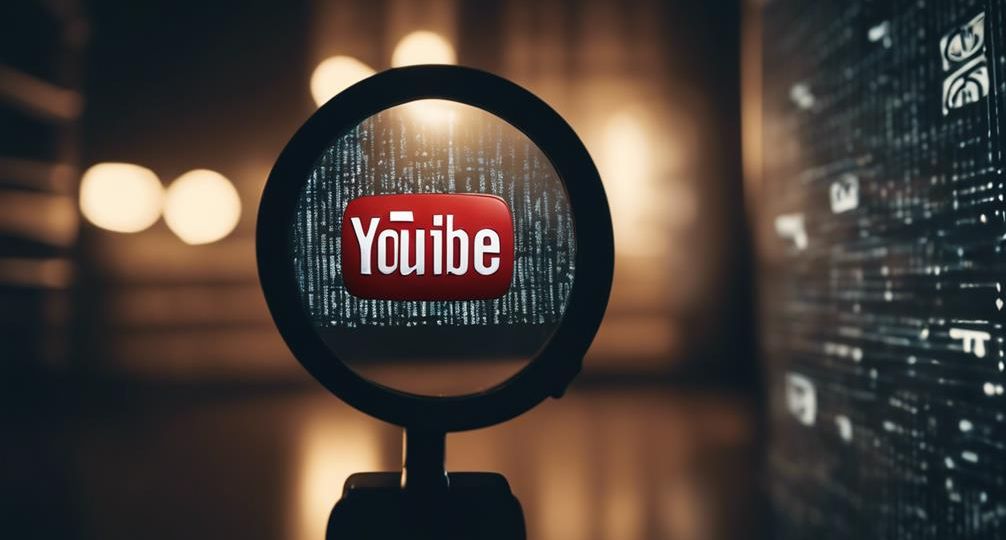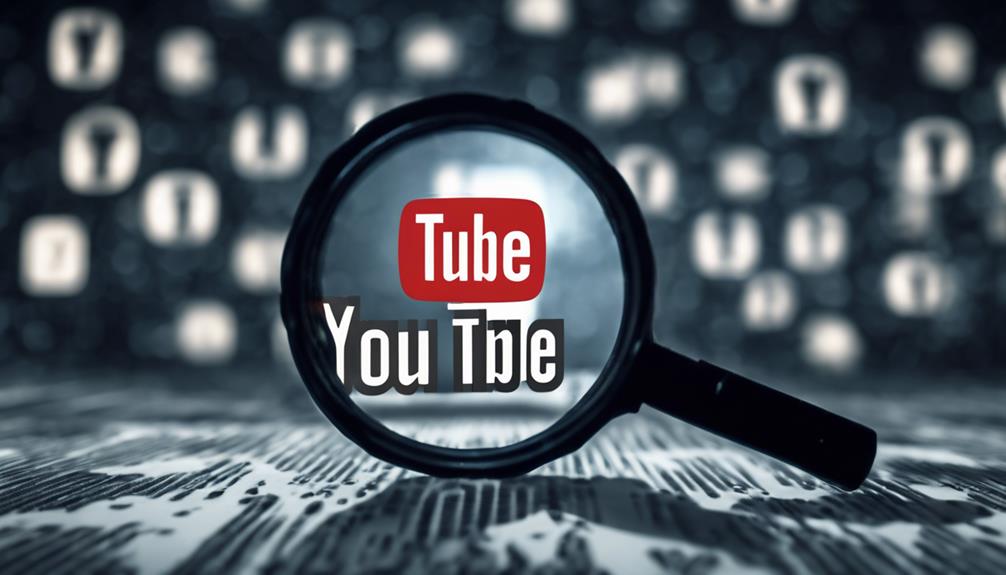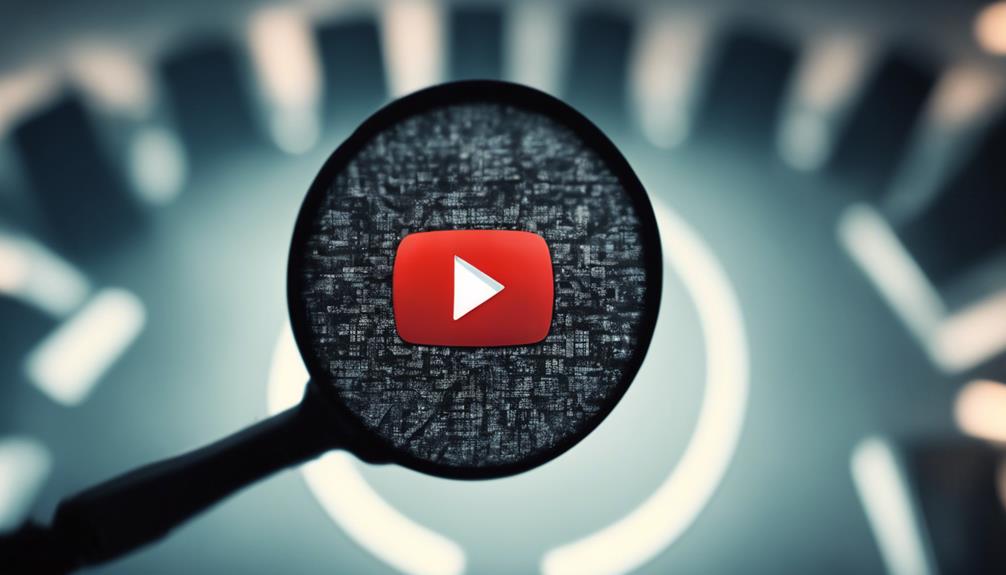
Can my YouTube account be traced?
Imagine you’re leaving footprints in the sand, each step you take forms a clear mark. That’s how your activity on the internet, including on YouTube, can be seen.
But, can these digital footprints lead back to your YouTube account? Is there a trail that points directly to you?
Well, you might be surprised at the answers to these questions, and it’s certainly worth considering how much of your online activity is truly anonymous.
Key Takeaways
- YouTube collects data such as IP address, browser type, and device information, potentially tracing back to your account.
- Your digital footprints, including active, passive, and hidden, reveal your online behaviors, making tracing possible.
- Privacy risks include personal data misuse, privacy breach, identity theft, and cyber-attacks using collected YouTube data.
- Enhancing privacy measures like incognito browsing, limiting ad personalization, protecting personal information, and using VPNs can help in reducing traceability.
Understanding YouTube’s Privacy Policies

To understand how your YouTube account can potentially be traced, it’s crucial to first delve into YouTube’s privacy policies and how they impact your online visibility. The ‘Privacy Settings Overview’ on YouTube is your first line of defense. It allows you to control who sees your playlists, likes, subscriptions, and videos. You can make your account as public or as private as you wish.
Understanding YouTube’s data encryption methods is equally important. YouTube uses industry-standard encryption methods to protect your data in transit and at rest. When you upload or download content, your data is encrypted using Transport Layer Security (TLS), ensuring that only authorized personnel can view it.
However, YouTube, being a service of Google, also collects and processes your data, including your IP address, browser type, and device information. This data is used to improve your user experience but also means that a trail is left behind, potentially revealing your identity to those who know how to look.
The Concept of Digital Footprints
While you’re surfing the web or using platforms like YouTube, you’re constantly leaving behind digital footprints. These are records and traces of your online activity that can be tracked and analyzed. This concept is central to footprint analysis and digital privacy. Every comment you post, every video you watch or like, even your browsing time, contributes to your digital footprint.
| Footprint Type | Example | Impact |
|---|---|---|
| Active Footprint | Posting a comment | Directly linked to you |
| Passive Footprint | Time spent watching a video | Collected without your active input |
| Hidden Footprint | Data collected by third-party cookies | Can be traced back to you indirectly |
These footprints aren’t just breadcrumbs in the digital world. They form a comprehensive picture of your online behavior, preferences, and habits which can be used for various purposes. By understanding your digital footprint, you’re taking a significant step towards safeguarding your digital privacy. Remember, every click counts, and every activity leaves an imprint. So it’s essential to be aware and maintain control over your digital footprints.
Potential Risks of YouTube Tracking
Understanding the concept of digital footprints brings us to the potential risks associated with YouTube tracking, as every interaction you make on the platform contributes to this footprint. The data you generate can be used in ways you mightn’t anticipate, potentially compromising your privacy and security. As more of your information becomes available online, your vulnerability to various risks increases.
Here are some potential risks associated with YouTube tracking:
- Personal Data Misuse: Your data can be used for targeted advertising, potentially leading to manipulation.
- Privacy Breach: Your viewing habits can reveal sensitive information about you, which can be exploited if fallen into wrong hands.
- Identity Theft: Detailed data can be used to impersonate you or commit fraud.
- Cyber Attacks: Your data can be used in phishing attacks or other cybersecurity threats.
- Regulatory Penalties: If you’re a content creator, incorrect data handling could lead to regulatory penalties.
To mitigate these risks, consider employing Tracking Prevention Methods and Cybersecurity Measures. Be aware of what data you’re sharing, and take proactive steps to protect your digital footprint. As technology advances, so should your strategies to maintain your online safety.
Can IP Addresses Be Traced?
Diving deeper into the realm of online tracking, you might be wondering if your IP address can be traced when using YouTube. The short answer is yes. YouTube, like many other online platforms, has the capability to trace IP addresses. Although they typically don’t disclose this information, law enforcement or legal entities can request it under certain circumstances.
However, don’t let this intimidate you. There are numerous cybersecurity measures available to safeguard your online privacy. IP masking techniques are one such solution. These methods involve concealing your real IP address, making it harder for anyone, including YouTube, to trace your activities back to you. They function by replacing your original IP address with a different one, thereby misleading trackers about your actual location.
Nevertheless, it’s crucial to remember that no cybersecurity measure is foolproof. Tracing IP addresses is a complex process, often involving multiple parties and intricate technological maneuvers. Therefore, it’s best to remain cautious and informed about the potential risks. If privacy is a major concern for you on YouTube or any other platform, consider exploring more about IP masking techniques and other cybersecurity measures to protect yourself.
The Role of Cookies in Tracking
You need to understand that cookies play a significant role in tracking online activities, including your YouTube account.
They’re small text files your browser stores to remember information about you, which can potentially compromise your privacy.
It’s crucial to grasp how they work and what you can do to protect your privacy.
Understanding Cookie Tracking
When it comes to online tracking, cookies play a critical role in linking your online activities to your personal identity. These small packets of data sent from a website and stored on your device have specific lifespans, often lasting until you clear your browsing data. They’re crucial for ad targeting, allowing advertisers to tailor content to your interests.
Understanding cookie tracking involves comprehending the following points:
- Cookies store information about your browsing habits.
- They can track which websites you visit and what you do on those sites.
- Advertisers use this data to create targeted advertising.
- The lifespan of a cookie can vary, with some lasting until you clear your browser data.
- You can manage and delete cookies through your browser settings.
Understanding these aspects can help you navigate the digital landscape more effectively.
Cookies and Privacy Concerns
Despite their usefulness, cookies raise significant privacy concerns due to their role in tracking online behavior. They can lead to Third Party Interference, where unknown entities gain access to your data.
Here’s a table that outlines the types of cookies, their purpose, and privacy concerns:
| Type of Cookie | Purpose | Privacy Concern |
|---|---|---|
| Session Cookies | Store data temporarily | Data vulnerable to interception |
| Persistent Cookies | Track user preferences | Data exposure over extended periods |
| Third-Party Cookies | Tailor advertising | Data shared with external entities |
To protect your privacy, consider using Data Encryption Techniques. These methods convert your information into a code, preventing unauthorized access. So, while cookies are necessary for user-friendly browsing, it’s crucial to understand their implications for privacy and take the necessary measures.
Enhancing Privacy on YouTube
To enhance your privacy on YouTube, it’s essential to understand the platform’s privacy settings and how they can be manipulated to protect your personal information. As a hub for innovative content and diverse communities, YouTube offers options to facilitate your anonymity and secure your browsing habits.
Here are five strategies to consider:
- Understand YouTube’s Privacy Settings: Familiarize yourself with the account’s privacy settings. Here, you can manage who sees your likes, subscriptions, playlists, and comments.
- Leverage Incognito Browsing: Incognito mode prevents YouTube from saving your search and viewing history. It’s an effective method to keep your activities untraced.
- Limit Ad Personalization: This reduces the amount of data collected about your viewing preferences and interests.
- Protect Your Personal Information: Refrain from posting sensitive data in your comments, video descriptions, or about page.
- Use a VPN: A Virtual Private Network provides an extra layer of security by masking your IP address.
Best Practices for YouTube Anonymity

In light of the ever-increasing digital footprint, you’ll want to take extra measures to maintain anonymity while using YouTube. Anonymity Techniques are your shield against unwanted exposure. Start by creating a dedicated email account for YouTube, without any personal information. Pseudonym Usage is another crucial step. Choose a username that doesn’t link back to you in any way.
When you’re online, be cautious of what you share. Avoid revealing details that could lead back to your real identity. Remember, the more personal information you provide, the easier it becomes for someone to trace your YouTube account.
Consider using a VPN (Virtual Private Network) to mask your IP address. This prevents your location from being tracked.
Here’s a quick reference table for YouTube Anonymity best practices:
| Best Practices | Description |
|---|---|
| Dedicated email | Create a new email without personal information for YouTube use |
| Pseudonym Usage | Choose a username not linked to your real identity |
| Share wisely | Be cautious of revealing personal details |
| VPN Usage | Use a VPN to hide your IP address |
| Regularly review settings | Regularly review and update your YouTube privacy settings |
Stay anonymous, stay safe!

